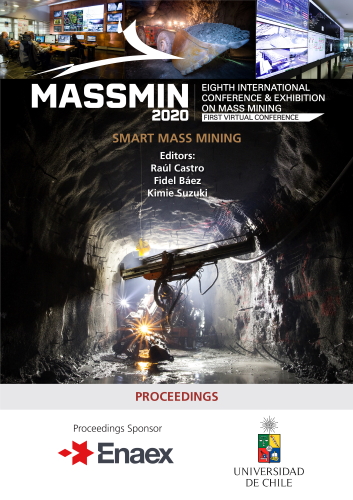Understanding surface subsidence from a block cave by comparing InSAR data with 3D numerical modeling

|
Authors: Kothari, UC; Sinaga, FM; Nguz Tshisens, J |
This paper is hosted with the kind permission of Lulea University of Technology, International Conference & Exhibition on Mass Mining, 2024.
DOI https://doi.org/10.36487/ACG_repo/2063_19
Cite As:
Kothari, UC, Sinaga, FM & Nguz Tshisens, J 2020, 'Understanding surface subsidence from a block cave by comparing InSAR data with 3D numerical modeling', in R Castro, F Báez & K Suzuki (eds), MassMin 2020: Proceedings of the Eighth International Conference & Exhibition on Mass Mining, University of Chile, Santiago, pp. 318-326, https://doi.org/10.36487/ACG_repo/2063_19
Abstract:
All mining operations have an inherent risk of instability related to rock excavations. For underground mines, the risk can be extended to the surface in the form of surface subsidence. Mining companies routinely use deformation monitoring to manage the geotechnical risks associated with the mining process. It can be challenging to monitor the extent and magnitude of subsidence with deformationmonitoring methods used for surface or underground mines. If a mine transitions from a surface mine to an underground mine, the existing monitoring techniques can be used to monitor small-scale effects of caving on the pit walls. It would be unrealistic, however, to measure the effects of subsidence using similar techniques for the whole area of influence. Numerical modeling is widely used to predict the effects of subsidence, based on small data sets available to calibrate the model. Now, satellite-based, interferometric synthetic aperture radar (InSAR) can be used to monitor deformation and subsidence over a wide range of areas. The technology has progressed to where measurements can be obtained every five to ten days. This is an efficient technique for covering large, slow-moving areas in comparison to the results obtained from numerical modeling. The data obtained can also be used to calibrate the numerical model to obtain better future predictions of subsidence. Today, the combination of satellite-based radar and numerical modeling has become an invaluable tool for monitoring and predicting the effects of subsidence. In this paper, a visual demonstration of results of movements from an active mine site should contribute to the understanding of how satellite-based radar data and numerical modeling can be used to show the effects of subsidence.
References:
Beck, DA, Sharrock, G & Capes, G 2011, ‘A coupled DFE-Newtonian Cellular Automata scheme for simulation of cave initiation, propagation and induced seismicity’, 45th US Rock Mechanics / Geomechanics Symposium in San Francisco, CA, June 26–29, 2011.
Brown, ET 2007, ‘Block Caving Geomechanics’, JKMRC: Brisbane.
Chandarana, UP, Momayez, M & Taylor, KT 2016, ‘Monitoring and Predicting Slope Instability: A Review of Current Practices From A Mining Perspective’, International Journal of Research in Engineering and Technology, vol. 05, Issue 11, pp. 139-151.
Mäkitaavola, K, Stöckel, B-M, Savilahti, T, Sjöberg, J, Dudley, J, McParland, MA & Morin, R 2018, ‘InSAR as a Practical Tool to Monitor and Understand Large-Scale mining-induced Ground Deformations in a Caving Environment’, in Y Potvin & J Jakubec (eds), Proceedings of Caving 2018, Vancouver, Canada, pp. 661–674.
Mäkitaavola, K, Stöckel, B-M, Sjöberg, J, Hobbs, S, Ekman, J, Henschel, M & Wickramanayake, A 2016, ‘Application of InSAR for monitoring deformations at the Kiirunavaara mine’, in HS Mitri, S Shnorhokian, MK Kumral, A Sasmito & A Sainoki
(eds), Proceedings of the 3rd International Symposium on Mine Safety, Science and Engineering, McGill University, Montreal, pp. 133–139.
Taylor, K, Ghuman, P & McCardle, A 2016, ‘Operational Mine Monitoring with InSAR’, in PM Dight (ed.), Proceedings of the First Asia Pacific Slope Stability in Mining Conference, Australian Center for Geomechanics, Perth, pp. 695-706.
Van As A, Davison J & Moss A 2003 ‘Subsidence definitions for block caving mines’, Rio Tinto technical services.
© Copyright 2025, Australian Centre for Geomechanics (ACG), The University of Western Australia. All rights reserved.
View copyright/legal information
Please direct any queries or error reports to repository-acg@uwa.edu.au
View copyright/legal information
Please direct any queries or error reports to repository-acg@uwa.edu.au
